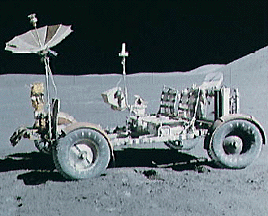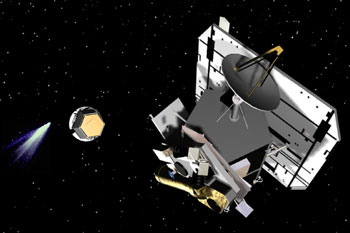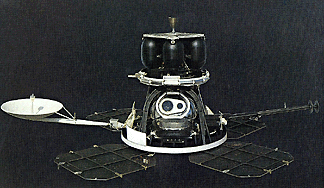View of Apollo 11 spacecraft on launch pad
Click on image for full size
NASA
Apollo 11
Apollo
11 was the first mission that landed a person
on the moon. On July 16, 1969, the U. S. rocket
Saturn 5 was launched carrying the lunar
landing module
Eagle. The Eagle was released and it reached the
Moon three days later. On July 20, millions of people back on Earth watched and listened
as astronaut Neil
Armstrong prepared to walk on the lunar surface.
"One small step for man, one giant leap for mankind". With these historic words, Armstrong became the first human to set foot on the Moon, leaving his footprint in the lunar soil. Over the next two and a half hours, he and another astronaut took photographs, collected soil and rock samples, and raised the American flag, while walking around on the Moon.
Apollo 11 returned safely to Earth on July 24, 1969. Today, the Apollo 11 mission is still one of the greatest space missions of all time.
You might also be interested in:

The Hubble Space Telescope (HST) is really neat! It was first launched in 1990, but scientists started building it in the 1970's! We have found all kinds of objects like stars, nebulae and galaxies. The
...more
Apollo 11 was the first mission that landed a person on the moon. On July 16, 1969, the U. S. rocket Saturn 5 was launched carrying the lunar landing module Eagle. The Eagle was released and it reached
...more
Apollo 12 was launched on Nov. 14, 1969 and arrived at the Moon three days later. Astronauts Charles Conrad and Alan Bean descended to its surface, while Richard Gordon remained in lunar orbit aboard the
...more
Apollo 15 marked the start of a new series of missions from the Apollo space program, each capable of exploring more lunar terrain than ever before. Launched on July 26, 1971, Apollo 15 reached the Moon
...more
NASA chose Deep Impact to be part of a special series called the Discovery Program. This program is for cheap, scientific projects. In May 2001, NASA said it was ok to start with mission development for
...more
Galileo was a spacecraft that orbited Jupiter for eight years. It made many discoveries about Jupiter and its moons. Galileo was launched in 1989, and reached Jupiter in 1995. The spacecraft had two parts.
...more
During 1966 through 1967, five Lunar Orbiter spacecrafts were launched, with the purpose of mapping the Moon's surface in preparation for the Apollo and Surveyor landings. All five missions were successful,
...more














